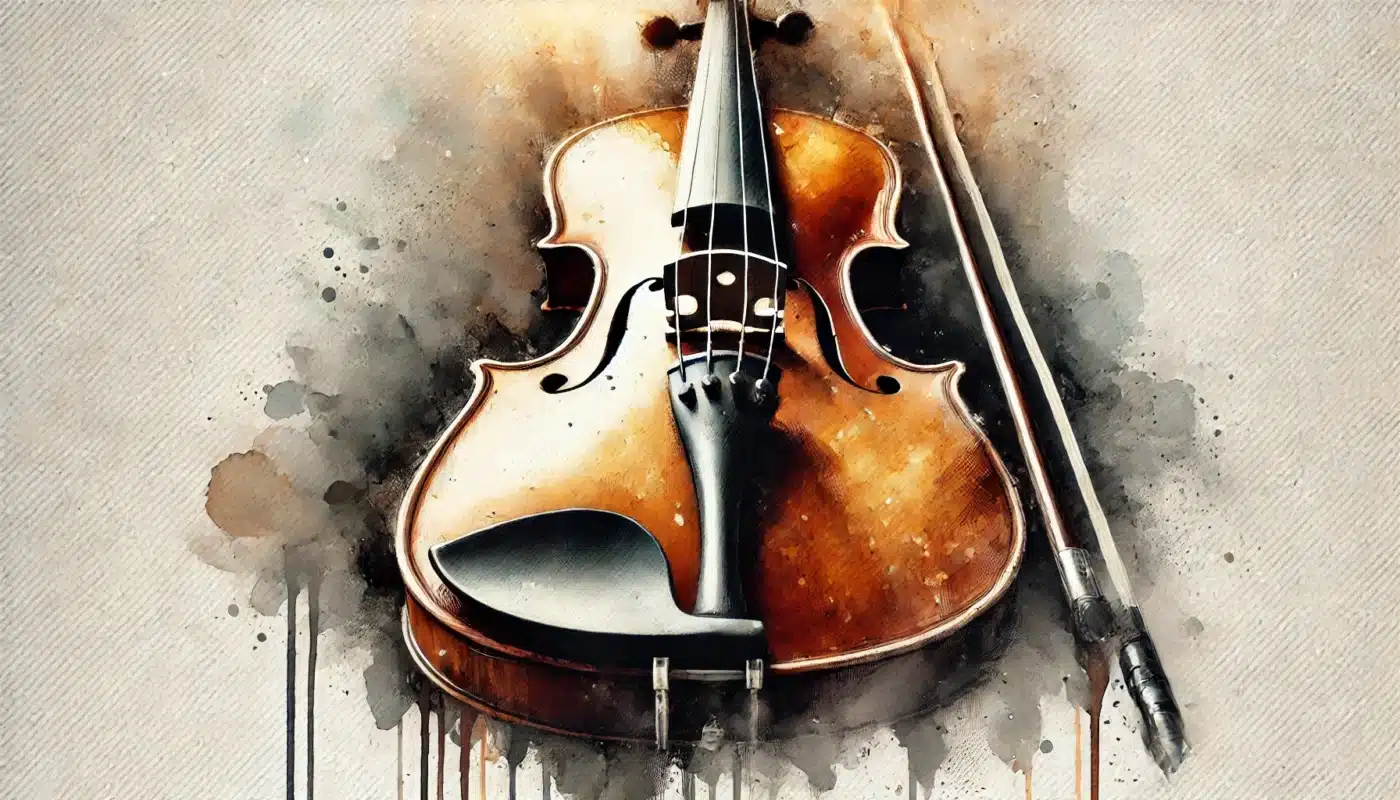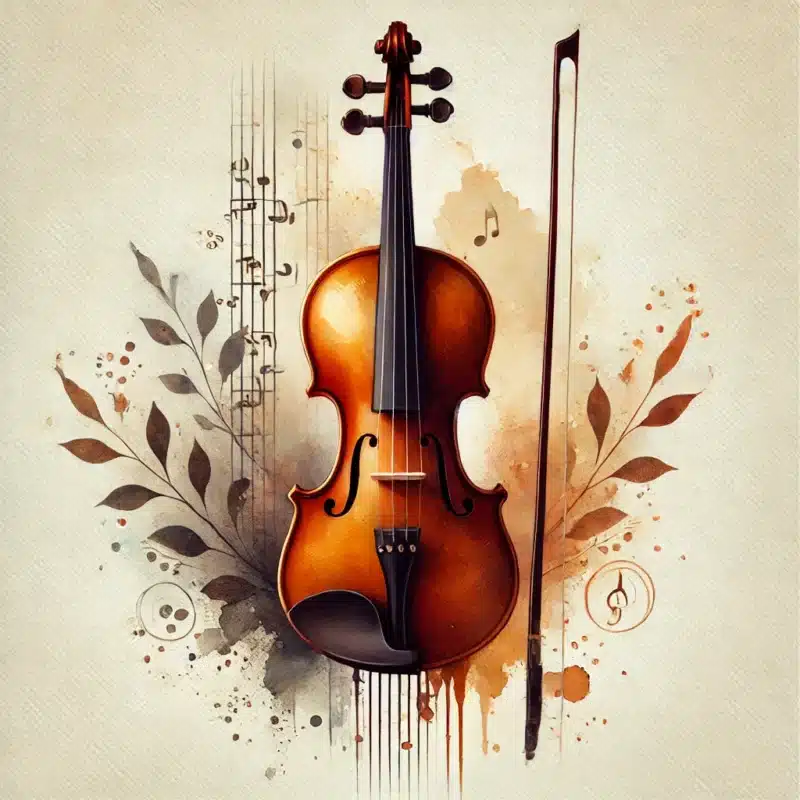The Traditional Violin – Four Strings
Exactly how many strings?
A traditional violin is designed with four strings and is the most commonly played instrument in the violin family. These violin strings are tuned in perfect fifths and are labeled, from the lowest to highest, as G, D, A, and E. This four-string setup is the standard for violins across the globe, especially in classical music, string ensembles, and chamber music.
Overview of the Standard Violin Strings
- G String (Lowest): The G string is the thickest string on the violin and produces the lowest pitch. It’s situated closest to the left when holding the violin in playing position.
- D String: Positioned just to the right of the G string, the D string offers a slightly higher pitch and is essential for producing the violin’s rich mid-tones.
- A String: The A string is higher in pitch than the D string and is often used as a reference point for tuning the other strings. The A and E strings are particularly important in solo performances.
- E String (Highest): The E string is the thinnest and produces the highest pitch. It’s typically used for playing the violin’s brightest and most piercing notes, making it a key component in the highest pitched instrument within the string family.
To easily remember the order of the strings, many musicians use mnemonics like “GReedy Daddy Always Eats” or “Good Dogs Always Eat.” These phrases help you quickly recall the sequence of G, D, A, and E strings.

The E String and Its Unique Role
The E string is not only the highest string on a violin but also one of the most important for delivering a sharp, clear sound. Due to its high tension and thinness, the E string can be more prone to breakage, requiring careful tuning and handling using the tuning pegs and fine tuners. It’s often equipped with a fine tuner, even on violins where the other strings don’t have them, allowing for precise adjustments.
The E string’s brilliance and piercing quality make it essential in solo performances and higher register playing. Many violinists consider the E string a defining feature of their instrument’s sound, particularly in fine historical instruments.
Variations – When Violins Have More Than Four Strings
Introduction to Non-Standard Violins
While the traditional violin is known for its four strings, there are variations of the instrument that include more strings. These non-standard violins are typically sought out by musicians looking to expand the violin’s range or achieve a different sound. However, it’s important to note that these violins are less common and are generally used in specific musical contexts.
5-String Violins
One of the most popular variations of the violin is the five-string violin. This type of violin includes an additional string below the G string, typically tuned to a C. The addition of this fifth string allows the violin to cover some of the range of a viola, making it a versatile choice for musicians who play across different genres, including folk music and rock genres.
The five-string violin is particularly favored in styles like jazz, folk music, and bluegrass, where musicians may desire the extended lower range without switching to a different instrument. However, due to its specialized nature, the five-string violin is rarely seen in classical music or traditional orchestral settings.
Electric Violins and Their Expanded String Configurations
Electric violins often push the boundaries of the traditional 4-string setup, with some models featuring 5, 6, seven strings, or even 8 strings. These additional strings expand the instrument’s range, allowing it to cover notes that would typically belong to a viola or even a double bass.
Electric violins are favored by musicians in genres such as rock, jazz, and non-western music cultures, where the extended range and unique sound possibilities can be fully explored. The design of electric violins also allows for amplification and effects that can drastically alter the instrument’s sound, making them a popular choice for contemporary musicians seeking to innovate.

Why Stick to Four Strings?
Benefits of the Traditional 4-String Violin
The traditional violin has stood the test of time for good reasons. Its design is both practical and efficient, offering a range of notes that spans nearly four octaves, which is more than enough for most musical compositions. Here’s why the 4-string setup continues to be the preferred choice for the majority of violinists:
- Simplicity and Ease of Learning: The 4-string violin is ideal for beginners because it is straightforward to learn and play. Fewer strings mean less complexity, making it easier for students to focus on mastering the fundamentals of technique, intonation, and finger placement.
- Widely Accepted Standard: The 4-string violin is the standard in classical music, orchestras, and most traditional music forms. Composers and arrangers write music specifically for this configuration, ensuring that violinists can seamlessly integrate into a wide range of ensembles without needing specialized instruments.
- Balanced Range and Playability: The four strings of a traditional violin are perfectly spaced to allow for a wide range of musical expression. The intervals between the strings (perfect fifths) make it easier to transition between notes, play double stops, and perform complex passages with clarity and precision.
The Rise of Synthetic Strings
In the past, violin strings were predominantly made from gut strings, which provided a rich, warm tone but required frequent tuning and had a shorter lifespan. Today, synthetic strings have become increasingly popular due to their durability and consistency. Made from synthetic materials like nylon or composite fibers, synthetic strings offer a balanced tone that closely mimics gut strings while providing greater stability in the violin strings tuned.
For many violinists, especially those who perform regularly, synthetic strings offer the best of both worlds: a reliable, consistent sound without the maintenance issues associated with gut strings. This makes them a popular choice for both professional musicians and serious students.
When Might More Strings Be Useful?
While the standard violin with four strings is sufficient for most musical needs, there are specific situations where additional strings might be beneficial. Musicians who play genres like jazz, folk, or experimental music may opt for violins with more strings to access a broader range of notes or to create unique sounds that a traditional violin cannot produce.
However, for most violinists, especially those focused on classical or traditional music, the additional strings are often unnecessary and can even complicate the learning process. The extra strings can make the instrument more difficult to play, and the altered setup might require adjustments in technique and finger positioning. In these cases, the fourth string of a traditional violin often provides all the range needed without the challenges that come with more strings.
Conclusion
In summary, the traditional violin is a four-string instrument, featuring the G, D, A, and E strings, which are tuned in perfect fifths. This configuration has been the standard for centuries and remains the most popular choice for violinists around the world. While there are variations of violins with additional strings—such as five-string, six-string, and even seven-string models—these are generally used in specific musical contexts and are not as widely adopted as the traditional 4-string setup.
The four-string violin strikes a perfect balance between simplicity, playability, and musical range, making it the ideal choice for most musicians. Whether you’re a beginner just starting out or an experienced player performing in a professional setting, the traditional 4-string violin offers everything you need to create beautiful, expressive music.
To easily remember the order of the strings, use mnemonics like “Greedy Daddy Always Eats” or “Good Dogs Always Eat.” These fun phrases help keep the sequence of G, D, A, and E strings fresh in your mind.
If you’re interested in learning more about the violin, need advice on choosing the right instrument, or are looking for a professional violinist for your event, feel free to explore more content on our site or get in touch directly. With the right violin and strings, the possibilities are endless.
Fun Random Facts
- A traditional violin is designed with four strings (g d a e) and is the most common instrument in the violin family.
- Violin strings are made from various materials, including gut, steel, and synthetic, each affecting the instrument’s sound and playability.
- Electric violins are modern adaptations of the traditional violin, often used in genres like rock and jazz for their amplified sound.
- The E string is the highest-pitched string on a violin, known for its bright and piercing tone.
- Synthetic strings are popular among violinists for their durability and ability to produce a sound similar to traditional gut strings.
- Violins are central to the string instruments family, which also includes cellos, violas, and double basses.
- When considering how many strings to choose, players can opt for the traditional four or explore variations with more.
- The standard violin has four strings, tuned in perfect fifths to G, D, A, and E.
- Violins are among the most popular stringed instruments, loved for their versatility in various musical genres.
- Tuning pegs on a violin are essential for adjusting the tension of the strings and achieving the correct pitch.
- Steel strings offer a brighter, more focused sound, often preferred by modern violinists.
- Gut strings are known for their warm, rich tone, traditionally used in baroque music and by players of historical instruments.
- Violin strings are tuned in perfect fifths, ensuring a balanced and harmonious sound across the instrument’s range.
- The violin is a prominent string instrument, celebrated for its expressive capabilities in both solo and ensemble settings.
- Playing an open string on a violin means bowing a string without pressing it down on the fingerboard.
- Sympathetic strings, used in instruments like the Hardanger fiddle, vibrate in harmony with the main strings to enhance the richness of sound.
- The A and E strings on a violin are used for higher-pitched notes and are essential for playing in the upper registers.
- Some electric violins feature seven strings, extending the instrument’s range beyond the traditional four.
- Violin bows are crafted from wood and horsehair and are crucial in producing sound by drawing across the strings.
- The modern violin, refined over centuries, remains a staple in both classical and contemporary music.
- The traditional violin has maintained its design and function for hundreds of years, remaining a key instrument in classical music.
- The D string on a violin offers a middle-range tone, often used for melody lines in orchestral and solo performances.
- A standard violin has four strings, each tuned in fifths to provide a wide range of notes.
- The violin is a cornerstone of classical music, featured prominently in solo, chamber, and orchestral works.
- For those wondering exactly how many strings a violin typically has, the answer is four.
- The string family of instruments, including violins, is integral to orchestral music, providing the foundation for harmony and melody.
- Fine tuners on a violin allow for precise adjustments to the pitch of each string, especially the E string.
- String ensembles, such as quartets, feature violins, violas, and cellos, showcasing the versatility of these instruments.
- The violin is a stringed instrument that is essential in many types of music, from classical to folk.
- Each tuning peg on a violin is used to adjust the pitch of one of the strings, ensuring the instrument is in tune.
- A five-string violin includes an extra C string, extending its range and allowing for greater versatility.
- Violin strings produce sound by vibrating when they are bowed or plucked, resonating through the instrument’s body.
- Some violins, particularly electric versions, feature many strings beyond the standard four, expanding the instrument’s range.
- The fourth string on a violin is the Gstring, providing the lowest notes.
- Playing the open A string is a common starting point for tuning the violin.
- The fifth string on an extended-range violin is typically a low C, adding depth to the instrument’s sound.
- The violin is one of the most celebrated solo instruments, capable of delivering a wide range of expressive sounds.
- Violins with additional strings, like five or seven-string models, are often used in jazz and experimental music.
- Smaller violin-type instruments, like the viola, offer different tonal ranges within the string family.
- Open strings on the violin provide the fundamental pitches of G, D, A, and E, which are crucial for tuning.
- Other stringed instruments, such as the cello and double bass, complement the violin in orchestral settings.
- Violins with five strings are used by musicians who need an extended range, particularly in genres like jazz.
- Thicker strings on a violin, produce lower, more resonant tones.
- The music played on a violin can range from intricate classical compositions to vibrant folk tunes.
- Electric basses, while different in function, share some similarities in design with electric violins, particularly in the use of amplification.
- Violin makers, or luthiers, are skilled craftsmen who build and repair violins, ensuring each instrument’s quality and sound.
- The double bass, the largest of the string instruments, provides the deep, foundational tones in orchestral and jazz music.
- Violinists rely on sheet music to learn and perform complex pieces, from classical symphonies to modern compositions.
- The hollow wooden body of a violin amplifies the sound produced by the vibrating strings, giving the instrument its rich tone.
- Old or worn-out strings can cause the violin’s sound to dull, necessitating regular string replacement for optimal performance.
- The violin’s range extends nearly four octaves, making it one of the most versatile instruments in the string family.
- Many modern violin strings are made from synthetic materials, offering a stable alternative to gut strings.
- Each individual string on a violin contributes to the overall tonal palette, from the deep G to the bright E string.
- The strings on a violin are crucial for producing the instrument’s sound, and their quality can greatly affect the music.
- Adding an additional string to a violin can expand its musical possibilities, often used in genres like jazz and rock.
- Perfect fifths are essential in violin tuning, creating the instrument’s characteristic sound and ease of play.
- Accurate finger placement is crucial for producing the correct pitches on a violin, especially in complex pieces.
- The lower strings of the violin, the G and D strings, provide a rich, warm foundation for the instrument’s sound.
- Each violin string is designed to produce a specific sound, contributing to the instrument’s overall tonal quality.
- The violin is a central instrument in many musical traditions, known for its expressive range and versatility.
- Applying too much pressure with the bow can cause the violin’s strings to sound harsh or produce an unwanted noise.
- The highest string on the violin is the E string, often used for playing melodies in the upper register.
- The lowest string on the violin is the G, used for deep, resonant notes.
- In the traditional sense, the violin has remained largely unchanged in design for hundreds of years.
- Rock genres have embraced electric violins for their amplified sound and unique musical possibilities.
- The violin is physically played by drawing a bow across its strings or by plucking them with the fingers.
- Each string on the violin is integral to its ability to produce a wide range of pitches and tones.
- Most violins are made from wood and feature four strings, though variations exist for different musical styles.
- The fundamental frequency of a violin string is determined by its length, tension, and mass, which together define its pitch.
- The strings of a standard violin are tuned to G, D, A, and E, forming the basis for the instrument’s sound.
- Violin strings should typically be changed every 6 to 12 months, depending on how often you play, as worn-out strings can cause a violin to sound dull, reducing its overall tonal quality. If your violin starts to sound dull before the usual 6 to 12 months, it may be time to change the strings, as fresh strings can restore the instrument’s bright and clear tone.
To hire a professional wedding violinist please visit the main site for details.



